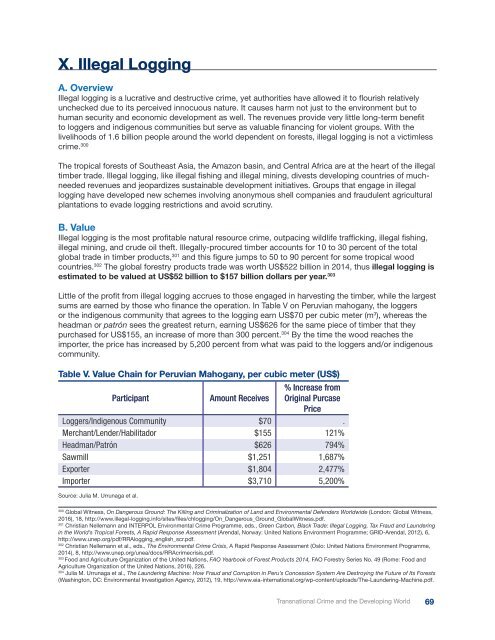Transnational Crime and the Developing World
Transnational_Crime-final
Transnational_Crime-final
You also want an ePaper? Increase the reach of your titles
YUMPU automatically turns print PDFs into web optimized ePapers that Google loves.
X. Illegal Logging<br />
A. Overview<br />
Illegal logging is a lucrative <strong>and</strong> destructive crime, yet authorities have allowed it to flourish relatively<br />
unchecked due to its perceived innocuous nature. It causes harm not just to <strong>the</strong> environment but to<br />
human security <strong>and</strong> economic development as well. The revenues provide very little long-term benefit<br />
to loggers <strong>and</strong> indigenous communities but serve as valuable financing for violent groups. With <strong>the</strong><br />
livelihoods of 1.6 billion people around <strong>the</strong> world dependent on forests, illegal logging is not a victimless<br />
crime. 300<br />
The tropical forests of Sou<strong>the</strong>ast Asia, <strong>the</strong> Amazon basin, <strong>and</strong> Central Africa are at <strong>the</strong> heart of <strong>the</strong> illegal<br />
timber trade. Illegal logging, like illegal fishing <strong>and</strong> illegal mining, divests developing countries of muchneeded<br />
revenues <strong>and</strong> jeopardizes sustainable development initiatives. Groups that engage in illegal<br />
logging have developed new schemes involving anonymous shell companies <strong>and</strong> fraudulent agricultural<br />
plantations to evade logging restrictions <strong>and</strong> avoid scrutiny.<br />
B. Value<br />
Illegal logging is <strong>the</strong> most profitable natural resource crime, outpacing wildlife trafficking, illegal fishing,<br />
illegal mining, <strong>and</strong> crude oil <strong>the</strong>ft. Illegally-procured timber accounts for 10 to 30 percent of <strong>the</strong> total<br />
global trade in timber products, 301 <strong>and</strong> this figure jumps to 50 to 90 percent for some tropical wood<br />
countries. 302 The global forestry products trade was worth US$522 billion in 2014, thus illegal logging is<br />
estimated to be valued at US$52 billion to $157 billion dollars per year. 303<br />
Little of <strong>the</strong> profit from illegal logging accrues to those engaged in harvesting <strong>the</strong> timber, while <strong>the</strong> largest<br />
sums are earned by those who finance <strong>the</strong> operation. In Table V on Peruvian mahogany, <strong>the</strong> loggers<br />
or <strong>the</strong> indigenous community that agrees to <strong>the</strong> logging earn US$70 per cubic meter (m 3 ), whereas <strong>the</strong><br />
headman or patrón sees <strong>the</strong> greatest return, earning US$626 for <strong>the</strong> same piece of timber that <strong>the</strong>y<br />
purchased for US$155, an increase of more than 300 percent. 304 By <strong>the</strong> time <strong>the</strong> wood reaches <strong>the</strong><br />
importer, <strong>the</strong> price has increased by 5,200 percent from what was paid to <strong>the</strong> loggers <strong>and</strong>/or indigenous<br />
community.<br />
Table V. Value Chain for Peruvian Mahogany, per cubic meter (US$)<br />
Participant<br />
Amount Receives<br />
% Increase from<br />
Original Purcase<br />
Price<br />
Loggers/Indigenous Community $70 .<br />
Merchant/Lender/Habilitador $155 121%<br />
Headman/Patrón $626 794%<br />
Sawmill $1,251 1,687%<br />
Exporter $1,804 2,477%<br />
Importer $3,710 5,200%<br />
Source: Julia M. Urrunaga et al.<br />
300<br />
Global Witness, On Dangerous Ground: The Killing <strong>and</strong> Criminalization of L<strong>and</strong> <strong>and</strong> Environmental Defenders <strong>World</strong>wide (London: Global Witness,<br />
2016), 18, http://www.illegal-logging.info/sites/files/chlogging/On_Dangerous_Ground_GlobalWitness.pdf.<br />
301<br />
Christian Nellemann <strong>and</strong> INTERPOL Environmental <strong>Crime</strong> Programme, eds., Green Carbon, Black Trade: Illegal Logging, Tax Fraud <strong>and</strong> Laundering<br />
in <strong>the</strong> <strong>World</strong>’s Tropical Forests, A Rapid Response Assessment (Arendal, Norway: United Nations Environment Programme; GRID-Arendal, 2012), 6,<br />
http://www.unep.org/pdf/RRAlogging_english_scr.pdf.<br />
302<br />
Christian Nellemann et al., eds., The Environmental <strong>Crime</strong> Crisis, A Rapid Response Assessment (Oslo: United Nations Environment Programme,<br />
2014), 8, http://www.unep.org/unea/docs/RRAcrimecrisis.pdf.<br />
303<br />
Food <strong>and</strong> Agriculture Organization of <strong>the</strong> United Nations, FAO Yearbook of Forest Products 2014, FAO Forestry Series No. 49 (Rome: Food <strong>and</strong><br />
Agriculture Organization of <strong>the</strong> United Nations, 2016), 226.<br />
304<br />
Julia M. Urrunaga et al., The Laundering Machine: How Fraud <strong>and</strong> Corruption in Peru’s Concession System Are Destroying <strong>the</strong> Future of Its Forests<br />
(Washington, DC: Environmental Investigation Agency, 2012), 19, http://www.eia-international.org/wp-content/uploads/The-Laundering-Machine.pdf.<br />
<strong>Transnational</strong> <strong>Crime</strong> <strong>and</strong> <strong>the</strong> <strong>Developing</strong> <strong>World</strong> 69


